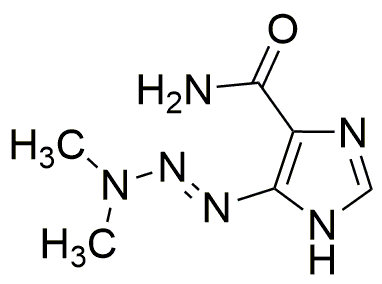Dacarbazine is widely utilized in research focused on
- Cancer Treatment: Primarily used as a chemotherapy agent for treating melanoma and Hodgkin's lymphoma, offering a vital option for patients with these conditions.
- Clinical Trials: Frequently involved in clinical studies to assess its efficacy in combination therapies, helping to advance cancer treatment protocols.
- Pharmaceutical Development: Serves as a reference compound in drug formulation research, aiding in the development of new anticancer drugs.
- Biochemical Research: Utilized in laboratory settings to study cellular responses to chemotherapy, providing insights into cancer cell behavior and resistance mechanisms.
- Veterinary Medicine: Occasionally explored for use in treating certain cancers in animals, expanding its application beyond human medicine.
Informations générales
Propriétés
Sécurité et réglementation
Applications
Dacarbazine is widely utilized in research focused on
- Cancer Treatment: Primarily used as a chemotherapy agent for treating melanoma and Hodgkin's lymphoma, offering a vital option for patients with these conditions.
- Clinical Trials: Frequently involved in clinical studies to assess its efficacy in combination therapies, helping to advance cancer treatment protocols.
- Pharmaceutical Development: Serves as a reference compound in drug formulation research, aiding in the development of new anticancer drugs.
- Biochemical Research: Utilized in laboratory settings to study cellular responses to chemotherapy, providing insights into cancer cell behavior and resistance mechanisms.
- Veterinary Medicine: Occasionally explored for use in treating certain cancers in animals, expanding its application beyond human medicine.
Documents
Fiches de données de sécurité (FDS)
La FDS fournit des informations de sécurité complètes sur la manipulation, le stockage et l’élimination du produit.
Spécifications du produit (PS)
Le PS fournit une description complète des propriétés du produit, notamment sa composition chimique, son état physique, sa pureté et les exigences de stockage. Il détaille également les plages de qualité acceptables et les applications prévues du produit.
Certificats d'analyse (COA)
Recherchez des certificats d'analyse (COA) en saisissant le numéro de lot du produit. Les numéros de lot et de lot se trouvent sur l'étiquette d'un produit, après les mots « Lot » ou « Lot de fabrication ».
Numéro de catalogue
Numéro de lot/série
Certificats d'origine (COO)
Ce certificat d'exploitation confirme le pays dans lequel le produit a été fabriqué, et détaille également les matériaux et composants utilisés et s'il est issu de sources naturelles, synthétiques ou autres sources spécifiques. Ce certificat peut être requis pour les douanes, le commerce et la conformité réglementaire.
Numéro de catalogue
Numéro de lot/série
Fiches de données de sécurité (FDS)
La FDS fournit des informations de sécurité complètes sur la manipulation, le stockage et l’élimination du produit.
DownloadSpécifications du produit (PS)
Le PS fournit une description complète des propriétés du produit, notamment sa composition chimique, son état physique, sa pureté et les exigences de stockage. Il détaille également les plages de qualité acceptables et les applications prévues du produit.
DownloadCertificats d'analyse (COA)
Recherchez des certificats d'analyse (COA) en saisissant le numéro de lot du produit. Les numéros de lot et de lot se trouvent sur l'étiquette d'un produit, après les mots « Lot » ou « Lot de fabrication ».
Numéro de catalogue
Numéro de lot/série
Certificats d'origine (COO)
Ce certificat d'exploitation confirme le pays dans lequel le produit a été fabriqué, et détaille également les matériaux et composants utilisés et s'il est issu de sources naturelles, synthétiques ou autres sources spécifiques. Ce certificat peut être requis pour les douanes, le commerce et la conformité réglementaire.


